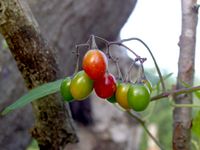Solanum dulcamara (weed)
| Literature database |
|---|
| 17 articles sorted by: |
| • year (recent ones first) |
| • research topics |
| • countries/regions |
| • affected crops |
Solanum dulcamara (weed) L. - (climbing nightshade)
This weed is native to parts of Europe and Asia and exotic in North America. It is commonly found in grasslands, wetlands and deciduous forests. It has been reported as a host of several crop diseases as well as pests. For example in some areas it harbours the bacterium causing the zebra chip disease of potatoes (Candidatus Liberibacter solanacearum) as well as the potato psyllid, Bactericera cockerelli which transmits the disease to nearby potato fields (Dahan et al., 2021).
| Vernacular names | |
|---|---|
| • Deutsch: | bittersüßer Nachtschatten |
| • English: | climbing nightshade woody nightshade bittersweet nightshade |
| • Français: | douce-amère |
Solanum dulcamara is a climbing plant with an above-ground length of up to 10 m. The leaves have a variable shape and can be heart-shaped, elliptical or lobed. The flower is star-shaped with purple or whitish petals and yellow stamens and style. The fruits are red egg-shaped berries, about 5-10 mm long. The stems can be used to extract medicinal compounds.
- Other images of Solanum dulcamara (weed) (Wikimedia Commons and IPM Images - click to enlarge)


